This circuit training workout for over 50 can help burn body fat, add sculpted muscle, and improve your health and appearance.
These exercises are appropriate for either men or women and can be modified to match a person’s unique fitness level.
Lower within this article, I’ve included a video of a circuit training workout. You can also use this video as inspiration and a jumping-off point to create your own results-effective circuit workouts.
Circuit Training Considerations for People Over 50
The genius of circuit training for people over 50 is that exercises that are healthier for the joints can be chosen.
Unlike weight-training machines and barbells that sometimes force exercisers into positions that can’t be organically adjusted, circuit training instead uses calisthenics, kettlebells, dumbbells, or resistance bands – and these are much better for allowing the exerciser to make organic, micro-modifications to their positioning in a way that is most comfortable for their joints.
Understanding the Logic Behind This Circuit Training Workout for Over 50
A “circuit” is a collection of exercises done consecutively.
My typical circuit training workout will involve the following:
- 4 completely different circuits.
- (each circuit contains approximately 5 exercises).
- At the end of the fifth exercise, I take a 3-minute rest before repeating the same circuit.
- I do the same circuit 3 times before moving on to an entirely new circuit.
A straightforward way to approach circuit training is to have a workout emphasize either upper body or lower body – this way, you can do two circuit-training workouts each week and adequately cover all the major muscle groups.
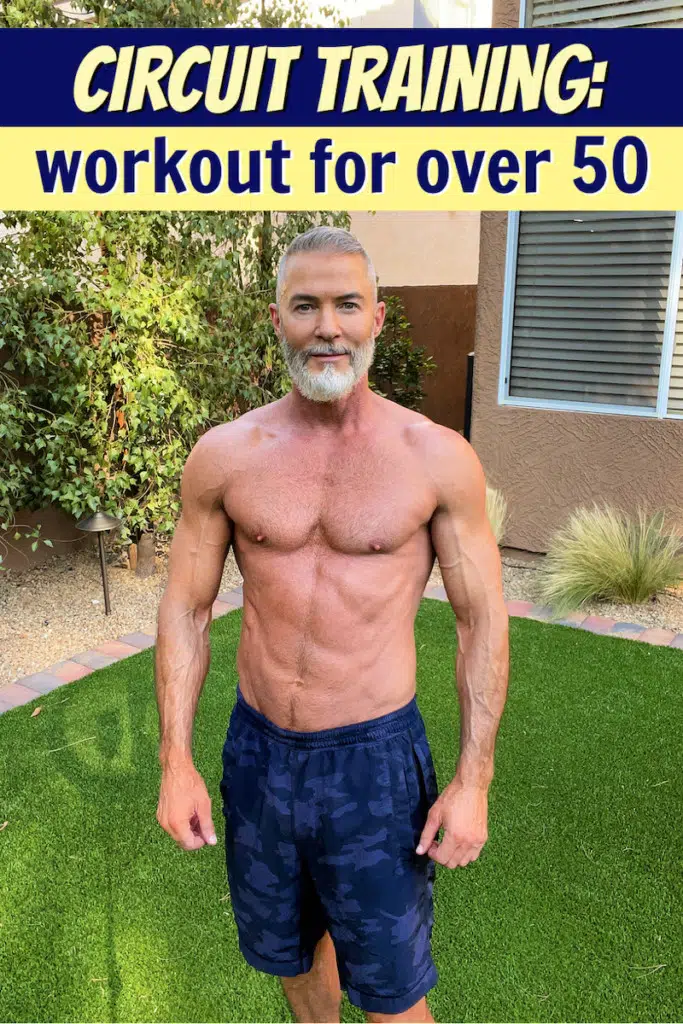
However, as I demonstrate below, you can also do a complete, full-body workout in one circuit training session.
What Equipment Do I Need for this Circuit Training Workout for Over 50?
Technically, you need no equipment whatsoever for a good circuit training workout. You can do bodyweight exercises only.
However, if you bring a few toys, it’s easier to program the circuit – and more fun while doing the workout. I have one of those inexpensive canvas boxes in which I keep:
- a kettlebell
- 2 resistance bands (one looped, one open)
- a magic circle
- a “hot yoga” towel
- a jump rope
- suspension straps (such as TRX)
- cleaning wipes
- spray sunscreen
- a clear folder with my written workout plan for the day (and past workouts, too).
I can develop over a hundred exercises with only these above items. Additionally, it helps to have a high bar available – such as a doorway chin-up bar or – if you’re at the park – playground monkey bars.
The Circuit Training Workout for Over 50
Circuit A:
- reverse kettlebell lunge
- jump rope
- decline push-up (for upper chest)
- supine mid-back row
- jump squat
Circuit B:
- hanging knee raise (for lower abdominals)
- squat thrust
- wide-grip pull-ups
- parallel bar push-up (or regular push-up)
- kettlebell step-up

Circuit C:
- sit-up (or crunch)
- single-leg heel raise
- chin-up tricep
- push-up
- kettlebell hip thrust
Circuit D:
- banded face pull
- kettlebell lateral raise
- pec-dec variation with magic circle
- lateral stationary kettlebell lunge
- jumping jack (optional finisher)
Tips for This Circuit Training Workout Over 50
In Circuit A, keep your pelvis centered (no swayback) and your abdominals slightly active when doing jump rope. This will keep your bladder from bouncing around and help protect the sensitive vertebrae of your lower back.
In Circuit B, when doing the hanging knee raise, try to engage the lower abdominals (above your pubic bone but below your navel) instead of letting your hip flexors do all the work.
In Circuit C, when doing the sit-up, the trick is to draw your navel in fiercely and initiate the movement from an abdominal contraction – instead of pulling on your neck.
In Circuit D, when doing the pec dec variation, you can use a ball if you don’t have a magic circle. Keep your spine tall, and your chest open – and try to squeeze from the pectoral muscles and not just from the front of your shoulder caps.
How to Design Your Own Excellent Circuits
You can program your own highly effective circuit-training workouts for your living room, backyard patio, or gym. Here’s what you need.
You can do a fantastic exercise session anywhere, especially after you learn the fundamental concepts of the circuit training workout for over 50.
Circuit-training workouts are time-efficient and an excellent way to improve cardiovascular fitness, mobility, and muscular strength endurance. Also, they burn more calories compared to other types of workouts.

I’ve been an enthusiast of fitness parks for years. Once you learn how to get the most out of fresh-air workouts, exercising indoors will never again feel as good.
However, sometimes – because of the weather – I do my circuit training indoors.
I can do a highly effective workout anywhere – in my living room, backyard patio, driveway, local neighborhood park, or gym.
Which Muscle Group Is Lagging Behind the Others?
Almost everyone has one muscle group that is a bit under-conditioned compared to the others. You can decide which muscle group is weakest in your body and train that body part at least twice a week.
For example, I typically do two circuit-training sessions each week – one for my torso and one for my legs – however, since I’ve identified my legs as “laggers,” I make sure to include some thigh exercises in my upper-body circuit day as well.
Look at yourself in the mirror, look at photos of yourself, and try to determine – honestly and objectively – which body part is your lagger (for most people, that’s their back muscles).
The symmetrically developed physique is not only more aesthetically pleasing, but it’s also healthier for your joints and posture. Many of the tenderness and stickiness people experience in their shoulders, lower back, hips, and knees are from muscular and mobility imbalances.
Being Prepared for a Circuit Training Workout for Over 50
I keep some extra exercise accessories in the trunk of my car – such as yoga blocks, ankle weights, an armband for my iPhone, a mat, etc. – that are fun to have available (though not strictly necessary).
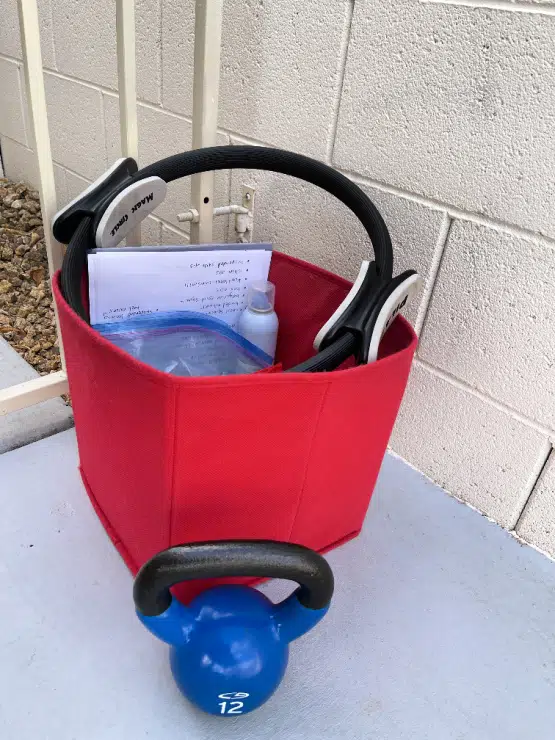
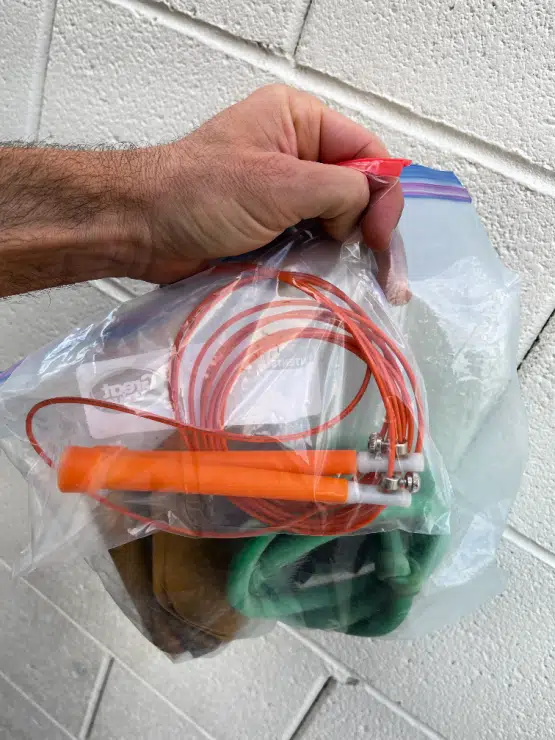
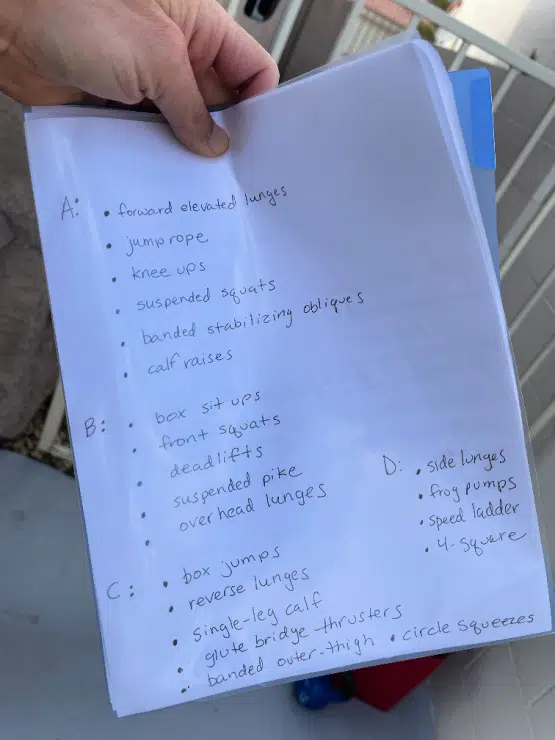
Avoiding the Common Pitfalls of a Circuit Training Workout After 50
I’ve done several hundred workouts in parks and identified some patterns.
Usually, during the 90 minutes of training, a few individuals will drop in and mess around with the equipment. They’re usually there for a few minutes before leaving. Most of them aren’t sure what to do.
A common mistake I see is people trying to workout at the park similar to how they exercise at the gym (do a “set,” rest a few minutes, do another set, etc.).
That usually doesn’t work.
Firstly, there are no machines to tell you what to do. Secondly, because there are no heavy stacks of weights at the park, you must increase effort in other areas (such as volume) for a highly effective workout. Try circuit training instead! I encourage you to experiment with:
- decreasing rest periods
- being more focused
- increasing your range of motion
- focusing on the quality of muscular contraction
- changing your tempo during a rep (from what you would typically do)
- doing more reps
- having a plan before you arrive.
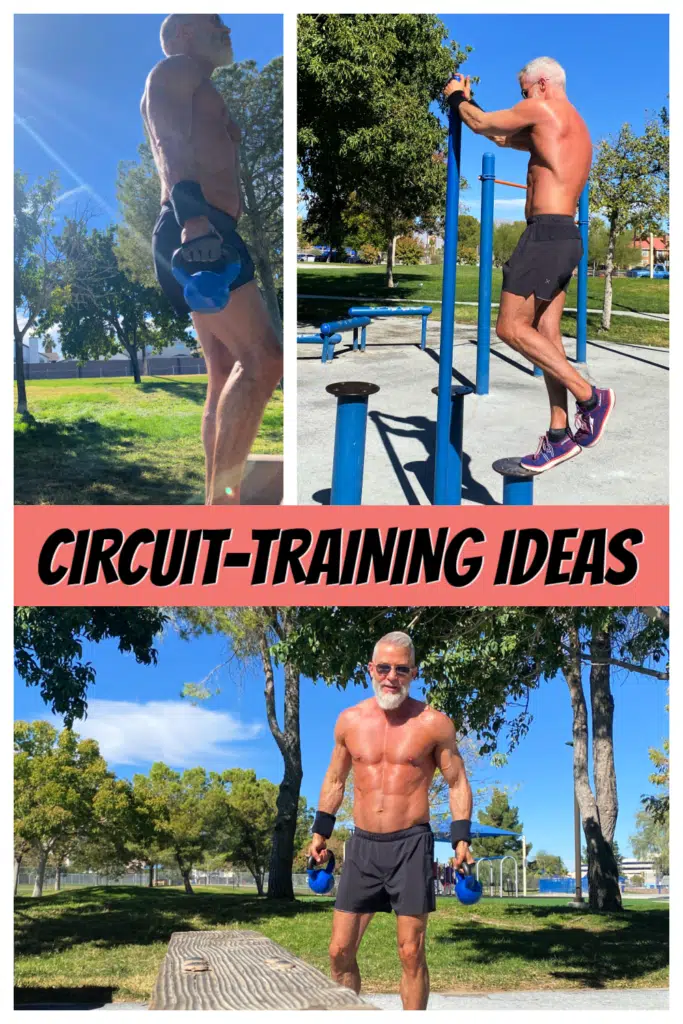
Choosing Muscle Groups to Train for Your Circuit
Choose which muscle groups you want to include in your circuit exercises; however, do keep symmetry in mind:
- Don’t neglect your hamstrings and glutes (the quads will hog all the leg work if you let them).
- If you train shoulders, remember to hit the posterior deltoids.
- Prioritize your core – include exercises for your lower abdominals, obliques, and lower back.
Your first circuit should include the most straightforward exercises and some mobility maneuvers to gradually ease you into more strenuous circuits to come.
If you want individual exercise ideas to place within your circuits, visit the links in this article or visit my Evidence-Based Fitness category on this site – it’s loaded with ideas. The video below has exercise ideas, too.

Circuit Training Workout for Over 50: Earbuds or No Earbuds?
Most of the time I workout, I do what everyone else does: listen to motivating music on my earbuds.
However, now and then, I’ll workout without music or podcasts.
I do that because exercising without wearing earbuds is a different experience.
Without earbuds, you focus differently. You make different choices, and it teaches you to rely on something internal for motivation instead of external.
Sports Psychologists report that earbuds can distract you, disrupting the body-and-mind connection, so you’re less tuned in to the subtle signals of your joints and muscles.
It’s also a good thing to be able to hear your surroundings. Though I sometimes use earbuds when running on trails, I never use them when running on the side of the road with cars. (Ask anyone who has gone to a grief group, and they will likely report that a surprising number of widows and widowers in the support group had spouses hit by cars while running or biking.)
Also, let’s face it, earbuds are kind of anti-social.
I’ve had great laughs and conversations with people I don’t know because I wasn’t wearing earbuds. And if you’re working out with a buddy, as I often do, I find it’s more fun without earbuds.
TIP: sterilize your earbuds now and then to avoid ear infections.
Circuit-training workouts are for men or women and can be easily modified to match any level of fitness or age.
Additional Sources for Circuit Training for Over 50:
Earbud Perils – https://abcnews.go.com/Health/w_DietAndFitnessNews/deaf-danger-perils-earbuds-exercising/story?id=13925714
Research: High-Intensity Circuit Training Improves Body Composition – https://www.frontiersin.org/articles/10.3389/fphys.2017.00172/full
Most Men Neglect Leg and Back Muscles – https://www.hfe.co.uk/blog/men-neglecting-lower-body-in-workouts/
Women Neglecting Core, Hamstring, and Pec Muscles – https://dailyburn.com/life/fitness/strength-training-for-women-neglected-muscles/
